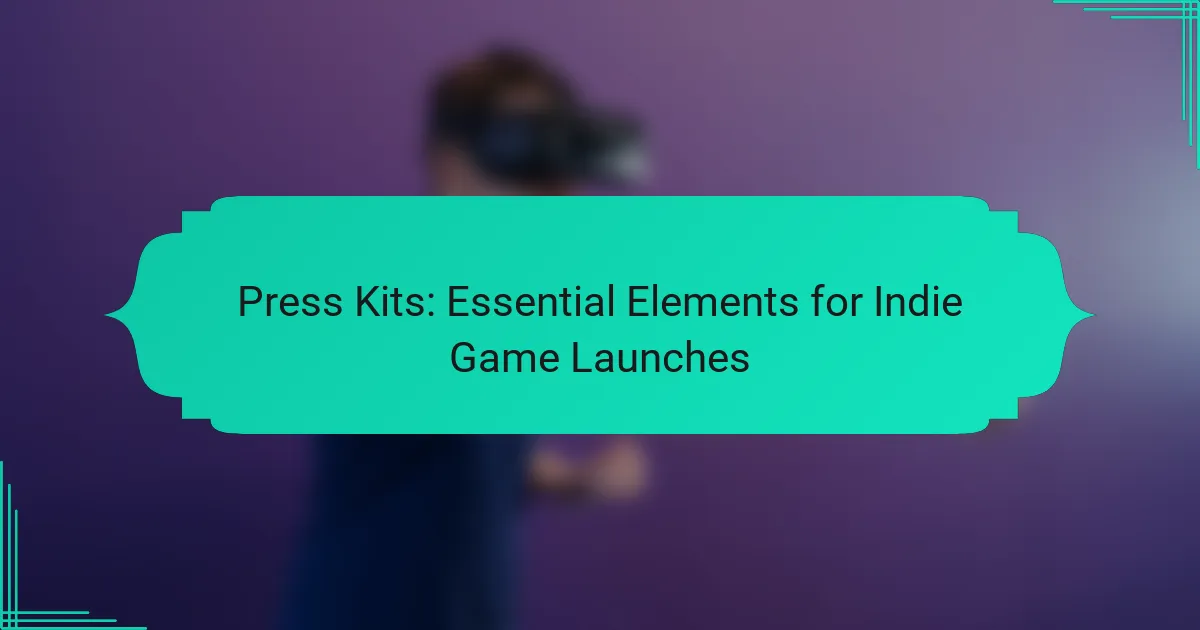Launching an indie game requires an effective press kit to capture media attention and engage players. Key components include a compelling press release, high-quality visuals, and a detailed fact sheet. Tailoring content for specific audiences, avoiding common pitfalls, and timing the release strategically are essential for maximizing visibility. Unique storytelling and interactive elements can further enhance the appeal of your press kit.
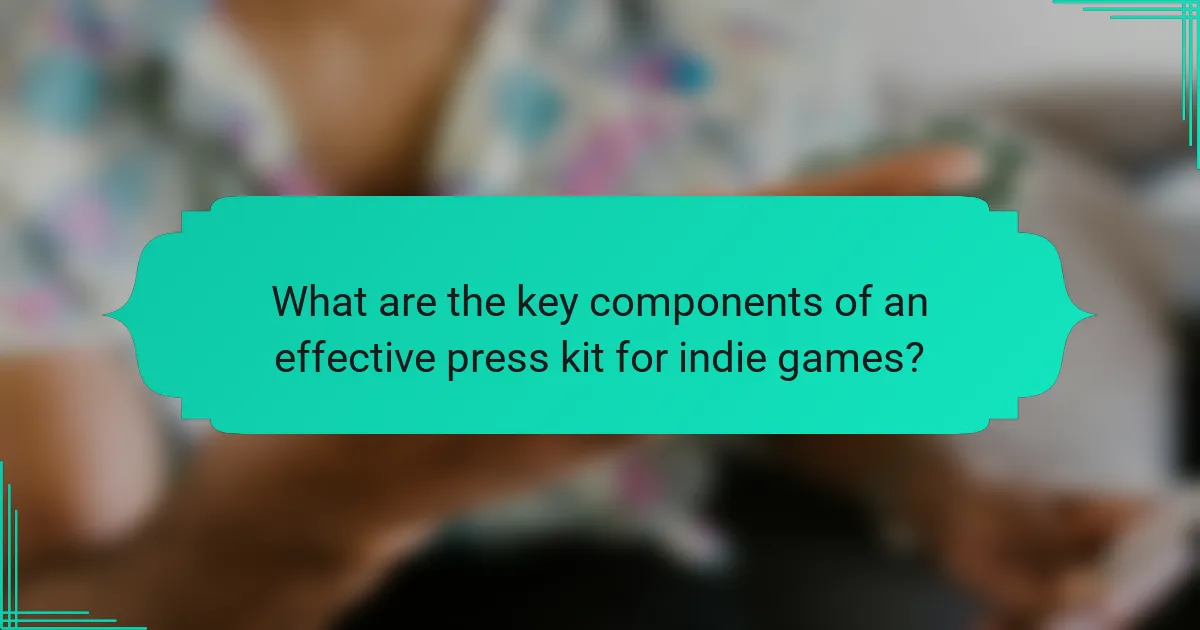
What are the key components of an effective press kit for indie games?
An effective press kit for indie games includes essential components that capture the game’s essence and appeal. Key elements are a compelling press release, high-quality visuals, and a detailed fact sheet.
The press release should summarise the game’s unique selling points and launch details. High-resolution images, including screenshots and logos, enhance visual appeal. A fact sheet offers critical information, such as game mechanics, platforms, and release dates.
Additional components like a developer biography and contact information can foster connections with media. Including gameplay trailers or demo links provides an engaging way for journalists to experience the game.
Finally, consider providing a FAQ section to address common inquiries. This comprehensive approach ensures the press kit effectively communicates the game’s value to potential players and the media.
How do visuals enhance the appeal of a press kit?
Visuals significantly enhance the appeal of a press kit by making it more engaging and informative. High-quality images, infographics, and videos capture attention and convey information quickly. They can illustrate game mechanics, showcase artwork, and highlight unique features, making the content more relatable. Visuals also enhance brand identity, helping to create a memorable impression. Additionally, they can improve retention of information, as audiences are more likely to remember visual content compared to text alone.
Which written materials are essential in a press kit?
A press kit for an indie game launch should include a press release, fact sheet, high-resolution images, a game trailer, developer bios, and contact information. These materials provide essential information and visual assets for media coverage.
| Material Type | Purpose |
|———————–|—————————————————|
| Press Release | Announce the game launch and key details |
| Fact Sheet | Summarise game features, release date, and platforms |
| High-Resolution Images | Provide visuals for media use |
| Game Trailer | Showcase gameplay and story elements |
| Developer Bios | Introduce the team behind the game |
| Contact Information | Facilitate media inquiries |
What role does a press release play in a press kit?
A press release serves as a critical component of a press kit by providing essential information about the indie game launch. It highlights key aspects such as the game’s features, release date, and unique selling points. This document ensures that journalists and media outlets have a concise, informative overview to share with their audiences. By including quotes from the developers and relevant visuals, the press release enhances the overall appeal of the press kit, making it more effective in generating media coverage and interest.

How can indie developers tailor press kits to different audiences?
Indie developers can tailor press kits by focusing on specific audience needs. Understanding the target audience helps shape content, visuals, and messaging.
1. Identify the audience: Determine if the target is gamers, media, or influencers.
2. Customise visuals: Use imagery that resonates with each audience segment.
3. Adjust messaging: Highlight aspects that appeal to each group, such as gameplay mechanics for gamers or development stories for media.
4. Include relevant assets: Provide different formats like trailers for gamers and interviews for media.
By adapting the press kit, developers enhance engagement and increase the chances of coverage.
What strategies work for engaging journalists and bloggers?
To engage journalists and bloggers effectively, create a comprehensive press kit that highlights your indie game’s unique attributes. Include high-quality visuals, a compelling press release, and relevant statistics about your game’s impact.
1. **Visual Assets**: Provide screenshots, trailers, and logos to capture attention.
2. **Press Release**: Write a concise narrative that outlines your game’s story and key features.
3. **Game Information**: Include details on release dates, platforms, and gameplay mechanics.
4. **Contact Information**: Ensure media contacts are easy to find for follow-up inquiries.
These elements enhance your visibility and encourage coverage from media outlets.
How to adapt press kits for influencers and content creators?
To adapt press kits for influencers and content creators, focus on personalization and relevance. Tailor the content to reflect the influencer’s audience, including unique visuals and engaging narratives that highlight your indie game’s distinct features.
Incorporate multimedia elements like videos and high-quality images to enhance appeal. Provide key information succinctly, such as game mechanics, release dates, and exclusive content access.
Ensure your press kit is easily accessible, ideally through a dedicated online link. This allows influencers to share the information seamlessly with their followers.
Lastly, include clear calls to action, encouraging influencers to engage with your game and share their experiences.
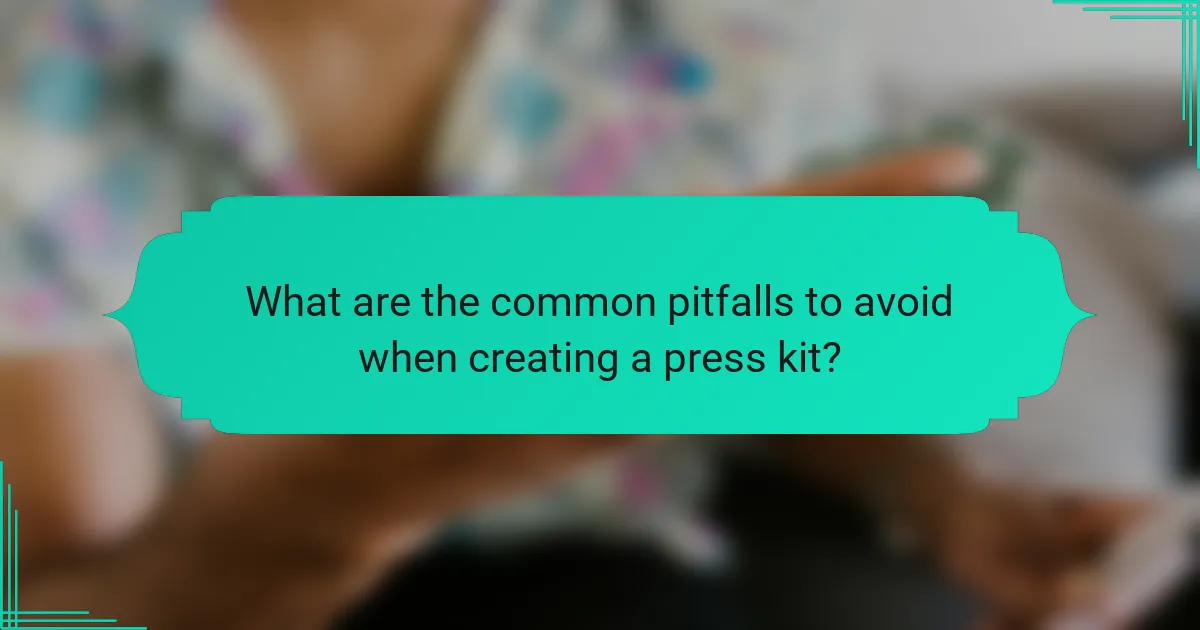
What are the common pitfalls to avoid when creating a press kit?
To avoid common pitfalls when creating a press kit, focus on clarity, relevance, and professionalism. Ensure your materials are well-organised, visually appealing, and tailored specifically for your audience.
1. Lack of focus: Avoid overwhelming information; stick to essential elements that highlight your game.
2. Poor design: Use a clean layout with high-quality visuals to engage readers effectively.
3. Ignoring target audience: Tailor content to the interests and needs of journalists and gamers.
4. Incomplete information: Include all necessary details, such as game mechanics, release dates, and contact information.
5. Neglecting updates: Regularly refresh your press kit to reflect the latest developments and media coverage.
Which mistakes can undermine the effectiveness of a press kit?
Common mistakes that can undermine the effectiveness of a press kit include lack of clarity, inadequate visuals, and missing key information. Clear messaging is crucial; if the content is confusing, it fails to engage. High-quality visuals attract attention; poor images can diminish interest. Omitting essential details like contact information or game specifics can lead to missed opportunities. Additionally, failing to tailor the press kit to the target audience can result in disconnection and reduced impact.
How can overloading information affect a press kit’s impact?
Overloading information can dilute a press kit’s effectiveness by overwhelming readers. A concise, focused press kit enhances clarity and engagement, ensuring key messages are communicated effectively. Too much information can lead to confusion, causing potential interest to wane. Prioritising essential elements fosters better retention and response from the target audience.

How does the timing of a press kit release influence game launches?
The timing of a press kit release significantly influences game launches by shaping media coverage and audience anticipation. A well-timed press kit can maximise visibility, ensuring the game captures attention during peak interest periods.
Releasing the press kit too early may lead to diminished excitement as the launch date approaches, while a late release can miss critical media opportunities. For indie games, aligning the press kit release with major gaming events or announcements can enhance reach and engagement.
Effective timing also allows developers to respond to feedback and adjust marketing strategies. A strategic release schedule can create buzz, driving pre-orders and increasing launch day sales.
What is the ideal timeline for distributing a press kit?
Distributing a press kit ideally begins four to six weeks before an indie game launch. This timeline allows ample time for journalists and influencers to engage with the material. Early distribution maximises exposure and builds anticipation. Ensure the kit includes essential elements like game descriptions, visuals, and contact information. Adjust the timeline based on the game’s complexity and target audience engagement.
How can seasonal events affect press kit strategies?
Seasonal events can significantly shape press kit strategies by aligning promotional efforts with relevant themes. For instance, holidays or major gaming conventions create opportunities to enhance visibility.
Press kits can leverage seasonal trends by incorporating timely visuals and messaging that resonate with audiences. This approach increases engagement and relevance, making the game more appealing during peak interest periods.
Additionally, unique attributes of the game can be highlighted to connect with seasonal narratives. For example, a winter-themed game can emphasise its cosy elements during the holiday season.
As a result, adapting press kit strategies to seasonal events maximises outreach and fosters a stronger connection with potential players.
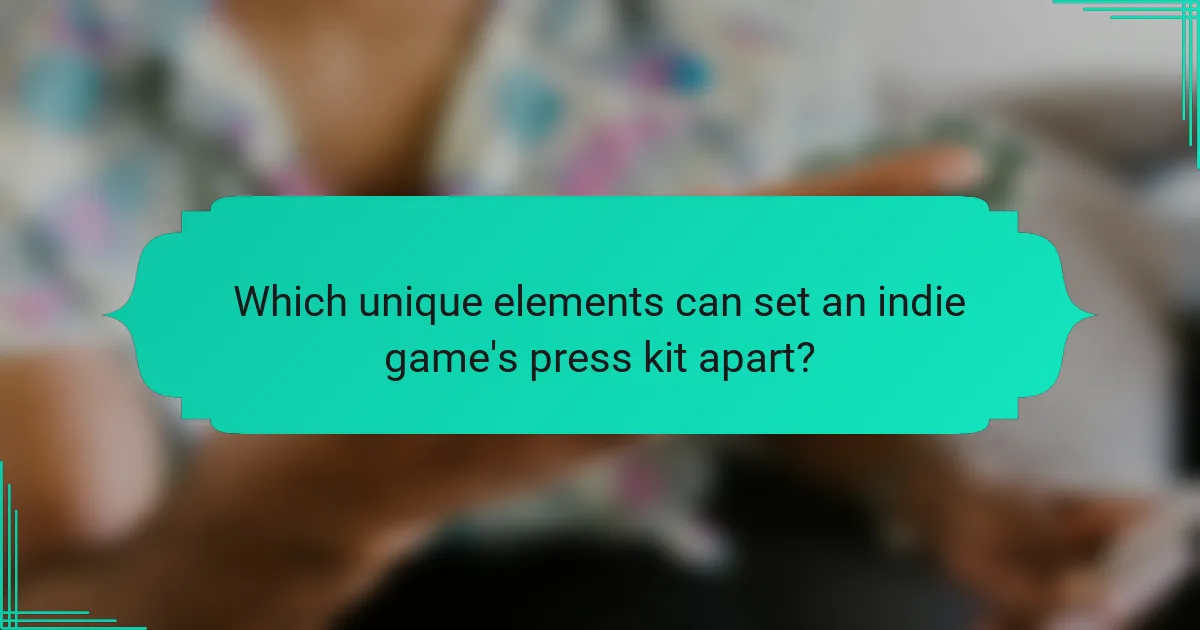
Which unique elements can set an indie game’s press kit apart?
Unique elements that can set an indie game’s press kit apart include personalised storytelling, engaging visuals, interactive elements, and exclusive content. These features enhance the appeal and provide a memorable experience for journalists and influencers. Personalised storytelling connects emotionally, while engaging visuals attract attention. Interactive elements allow for deeper exploration of the game, and exclusive content can generate buzz and interest.
What innovative formats have successfully captured attention?
Press kits that incorporate multimedia elements, interactive content, and personalised outreach have successfully captured attention. Innovative formats such as video trailers, infographics, and playable demos engage audiences more effectively than traditional text-based materials. These formats enhance storytelling and provide immersive experiences, making them memorable. Additionally, incorporating user-generated content fosters community involvement and boosts visibility during indie game launches.
How can storytelling enhance a press kit’s narrative?
Storytelling enhances a press kit’s narrative by creating emotional connections and engaging the audience. It allows indie games to convey their unique themes, characters, and experiences, making them memorable. Strong narratives in press kits can differentiate a game from competitors, highlighting its unique attributes and core message. This approach fosters deeper engagement, encouraging media coverage and player interest.
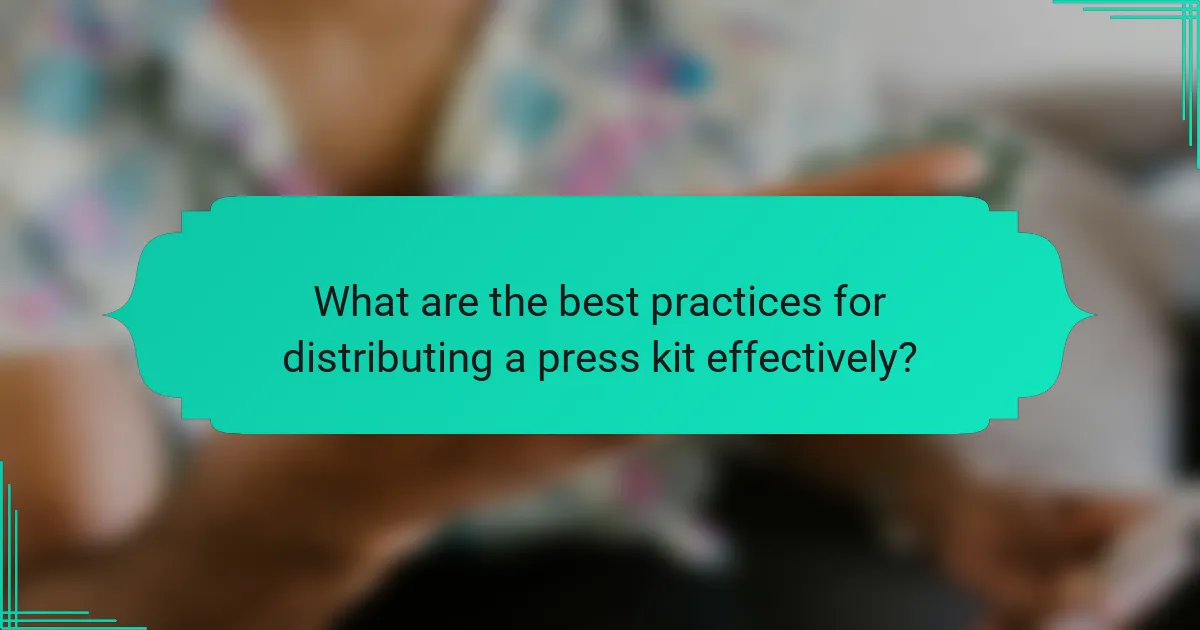
What are the best practices for distributing a press kit effectively?
Distributing a press kit effectively involves strategic planning and targeted outreach. Start by identifying your audience, which includes journalists, influencers, and gaming communities. Utilise email for direct communication, ensuring your press kit is easily accessible through a downloadable link. Leverage social media platforms to share engaging snippets from your press kit, encouraging shares and interactions. Consider timing your distribution around key events or announcements to maximise visibility. Finally, follow up with recipients to gauge interest and encourage coverage.
How to leverage social media for press kit distribution?
Utilise social media platforms to effectively distribute press kits by targeting relevant audiences and engaging with influencers. Share visually appealing content that highlights key features of the indie game.
1. Identify platforms where your target audience is active, such as Twitter, Instagram, or Discord.
2. Create engaging posts that summarise your press kit’s highlights, using eye-catching visuals and concise messaging.
3. Leverage hashtags and tags to increase visibility and reach within the gaming community.
4. Engage with followers by responding to comments and sharing user-generated content related to your game.
5. Collaborate with gaming influencers to amplify your press kit distribution and reach a wider audience.
Which platforms are most effective for sharing press kits?
Social media platforms, gaming forums, and press release distribution services are most effective for sharing press kits. Platforms like Twitter, Facebook, and Instagram allow direct engagement with audiences. Gaming-specific sites such as Reddit and Discord facilitate targeted outreach. Press release services like PR Newswire enhance visibility across media outlets. Each platform offers unique advantages for reaching potential players and industry influencers.
What follow-up strategies can maximize press kit visibility?
To maximise press kit visibility, follow targeted outreach and engagement strategies. Focus on building relationships with journalists and influencers in the gaming industry. Personalise your communications, emphasising the unique aspects of your indie game. Utilise social media platforms to share press kit content, encouraging shares and interactions. Monitor and analyse the impact of your strategies, adjusting based on what resonates most with your audience.
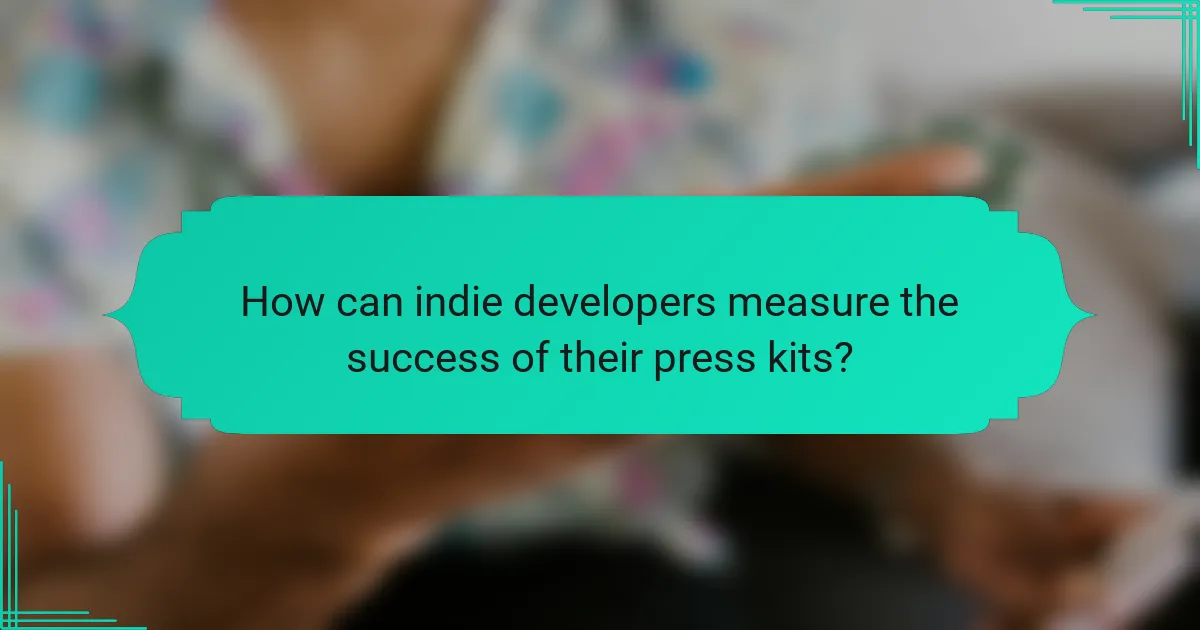
How can indie developers measure the success of their press kits?
Indie developers can measure the success of their press kits by tracking media coverage, engagement metrics, and player feedback. Key indicators include the number of press mentions, social media shares, and website traffic generated from press kit outreach. Analysing these metrics helps refine future press kit strategies.
Which metrics should be tracked post-launch?
Track metrics such as user engagement, download rates, social media reach, press coverage, player feedback, and revenue post-launch. These metrics provide insights into the success of the press kit and overall game performance.
| Metric | Description |
|———————-|———————————————–|
| User Engagement | Measures player interactions and retention |
| Download Rates | Tracks the number of game downloads |
| Social Media Reach | Evaluates the impact of social media campaigns|
| Press Coverage | Assesses media mentions and reviews |
| Player Feedback | Collects player opinions and suggestions |
| Revenue | Monitors financial performance post-launch |
How can feedback improve future press kit efforts?
Feedback enhances future press kit efforts by identifying strengths and weaknesses. It allows for the refinement of content, ensuring it resonates with the target audience. Analysing past press kits reveals which elements generated the most interest, helping to tailor future communications effectively. Incorporating feedback fosters continuous improvement, ultimately leading to more successful indie game launches.
What tools can assist in evaluating press kit performance?
Analytics tools can effectively evaluate press kit performance. Key options include Google Analytics for tracking website traffic, social media analytics for engagement metrics, and PR tracking tools like Cision for media coverage insights. These resources provide data on reach, impressions, and audience engagement, essential for assessing press kit impact.
What are the top tips for optimizing press kits for future launches?
To optimise press kits for future indie game launches, focus on clarity, engagement, and accessibility. Start with a compelling press release that highlights unique features and gameplay. Include high-quality visuals and videos to capture attention. Provide easy access to downloadable assets and clear contact information for media inquiries. Tailor the content to specific audiences to enhance relevance and impact.
